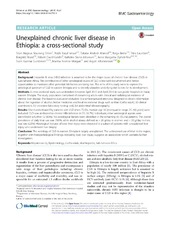| dc.contributor.author | Orlien, Stian Magnus Staurung | en_US |
| dc.contributor.author | Ismael, Nejib Yusuf | en_US |
| dc.contributor.author | Ahmed, Tekabe Abdosh | en_US |
| dc.contributor.author | Berhe, Nega | en_US |
| dc.contributor.author | Lauritzen, Trine | en_US |
| dc.contributor.author | Roald, Borghild | en_US |
| dc.contributor.author | Goldin, Robert David | en_US |
| dc.contributor.author | Stene-Johansen, Kathrine | en_US |
| dc.contributor.author | Dyrhol-Riise, Anne Ma | en_US |
| dc.contributor.author | Gundersen, Svein Gunnar | en_US |
| dc.contributor.author | Morgan, Marsha Yvonne | en_US |
| dc.contributor.author | Johannessen, Asgeir | en_US |
| dc.date.accessioned | 2019-06-20T12:47:03Z | |
| dc.date.available | 2019-06-20T12:47:03Z | |
| dc.date.issued | 2018-02-13 | |
| dc.Published | Orlien SMS, Ismael, Ahmed, Berhe N, Lauritzen T, Roald B, Goldin, Stene-Johansen K, Dyrhol-Riise AM, Gundersen SG, Morgan, Johannessen A. Unexplained chronic liver disease in Ethiopia: a cross-sectional study. BMC Gastroenterology. 2018;18(1):27 | eng |
| dc.identifier.issn | 1471-230X | |
| dc.identifier.uri | https://hdl.handle.net/1956/20292 | |
| dc.description.abstract | Background: Hepatitis B virus (HBV) infection is assumed to be the major cause of chronic liver disease (CLD) in sub-Saharan Africa. The contribution of other aetiological causes of CLD is less well documented and hence opportunities to modulate other potential risk factors are being lost. The aims of this study were to explore the aetiological spectrum of CLD in eastern Ethiopia and to identify plausible underlying risk factors for its development. Methods: A cross-sectional study was undertaken between April 2015 and April 2016 in two public hospitals in Harar, eastern Ethiopia. The study population comprised of consenting adults with clinical and radiological evidence of chronic liver disease. The baseline evaluation included: (i) a semi-structured interview designed to obtain information about the ingestion of alcohol, herbal medicines and local recreational drugs such as khat (Catha edulis); (ii) clinical examination; (iii) extensive laboratory testing; and, (iv) abdominal ultrasonography. Results: One-hundred-and-fifty patients with CLD (men 72.0%; median age 30 [interquartile range 25–40] years) were included. CLD was attributed to chronic HBV infection in 55 (36.7%) individuals; other aetiological agents were identified in a further 12 (8.0%). No aetiological factors were identified in the remaining 83 (55.3%) patients. The overall prevalence of daily khat use was 78.0%, while alcohol abuse, defined as > 20 g/day in women and > 30 g/day in men, was rare (2.0%). Histological features of toxic liver injury were observed in a subset of patients with unexplained liver injury who underwent liver biopsy. Conclusion: The aetiology of CLD in eastern Ethiopia is largely unexplained. The widespread use of khat in the region, together with histopathological findings indicating toxic liver injury, suggests an association which warrants further investigation. | en_US |
| dc.language.iso | eng | eng |
| dc.publisher | BioMed Central | eng |
| dc.relation.uri | https://bmcgastroenterol.biomedcentral.com/track/pdf/10.1186/s12876-018-0755-5?site=bmcgastroenterol.biomedcentral.com | |
| dc.rights | Attribution CC BY | eng |
| dc.rights.uri | http://creativecommons.org/licenses/by/4.0 | eng |
| dc.subject | Hepatotoxicity | eng |
| dc.subject | Epidemiology | eng |
| dc.subject | Catha edulis | eng |
| dc.subject | Viral hepatitis | eng |
| dc.subject | Sub-Saharan Africa | eng |
| dc.title | Unexplained chronic liver disease in Ethiopia: a cross-sectional study | en_US |
| dc.type | Peer reviewed | |
| dc.type | Journal article | |
| dc.date.updated | 2019-02-05T12:31:46Z | |
| dc.description.version | publishedVersion | en_US |
| dc.rights.holder | Copyright 2018 The Author(s) | |
| dc.identifier.doi | https://doi.org/10.1186/s12876-018-0755-5 | |
| dc.identifier.cristin | 1566298 | |
| dc.source.journal | BMC Gastroenterology | |
| dc.relation.project | Helse Sør-Øst RHF: 544480 | |
| dc.relation.project | Norges forskningsråd: 220622 | |
| dc.relation.project | Norges forskningsråd: 544480 | |

